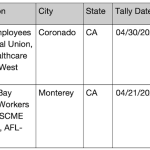
STUDY: Interacting with these popular right-leaning comedy podcasters can turn your TikTok feed into a swamp of Andrew Tate-style misogyny and conspiracy theories
May 19, 2025
Making Expensive Cities Into Union Towns
May 19, 2025On Saturday, I asked Andriy Sadovyi, the mayor of Lviv, in western Ukraine, whether he expected the Russian-Ukrainian talks in Istanbul to lead to a cease-fire. “No,” he told me. Later, I asked the audience at the Lviv Media Forum whether any of them expected a cease-fire soon. About 200 journalists and editors were in the room. No one raised their hand. Many laughed.
Over several days in Lviv I didn’t meet anybody who believed that the Russian president wants to end the war, or that he will negotiate to do so in Istanbul. Ukrainian reasoning is straightforward: Vladimir Putin has never said he wants to end the war. The propagandists on Russian state television have never said they want to end the war. The Russian negotiating team in Istanbul did not say it wanted to end the war. On the contrary, the head of the Russian delegation, Vladimir Medinsky, told the Ukrainians, “We fought Sweden for 21 years. How long are you ready to fight?” (The Great Northern War, to which Medinsky was presumably referring, concluded in 1721. Also, Medinsky is best-known not for any battlefield heroics but for rewriting school textbooks).
At the same meeting, the Russians demanded that Ukraine withdraw from land that Ukraine controls; threatened to annex more provinces, something they have been trying and failing to do for three years; and insulted a member of the Ukrainian delegation, who lost a nephew in the fighting. “Maybe some of those sitting here at the table will lose more of their loved ones,” Medinsky sneered.
Ukrainians find none of this surprising, because they have been listening to this kind of language for three years. What they do find surprising is the American president’s tolerance for what looks to them like open mockery. President Donald Trump says he wants a peace negotiation. Ukrainian President Volodymyr Zelensky prepared for a peace negotiation. The Russian president turned it into a farce, and will likely proceed with the farce, stringing out Trump for as long as possible and agreeing to more phone calls and meetings in order to avoid new sanctions, distract attention from Russia’s ongoing war crimes, and make the U.S. appear weak.
I will not here offer a full explanation for why Trump does not understand the game that Putin is playing, one that is obvious to absolutely everyone else. I will note only that Trump repeatedly misunderstands Putin, overrates his alleged friendship with Putin, and often attributes to Putin motives that are really his own. “Putin is tired of this whole thing,” Trump said on Fox News. “He’s not looking good. And he wants to look good.” In reality, it is Trump who is tired of “this whole thing,” Trump who’s not looking good, and Trump who wants to look good.
Putin, meanwhile, has redirected his entire economy toward military production, in the manner of the Soviet Union or Nazi Germany. He has created a regime so repressive that people are afraid to use the word war in public. He regularly sacrifices hundreds or even thousands of men to gain 100 yards of territory. What that looks like to other people can hardly be of much interest to him.
For all of those reasons, Ukrainians believe the war will continue, and the prospect no longer scares them. Partly this is because they have no other choice. Unlike the Russians, who could withdraw from the battlefield and go home at any time, the Ukrainians cannot withdraw from the battlefield. If they do, they will lose their civilization, their language, and their freedom. Under Russian occupation, the mayor of Lviv and the journalists at the Lviv Media Forum would end up in prison or dead, just like their murdered and imprisoned colleagues in Russian-occupied Ukraine today.
More to the point, Ukrainians are confident that they can continue fighting, even without the same level of American support. The Ukrainian army is not retaking territory, as it did in the autumn of 2022, nor does it have plans for a major new counteroffensive. But neither is it losing. The tanks and heavy equipment that Ukraine needed from others don’t matter as much as they did two years ago. The Ukrainians still need American intelligence and anti-missile defenses to protect civilians in their cities. They still get weapons and ammunition from Europe. But on the frontline, this conflict has become a drone war, and Ukraine both produces drones—more than 2 million last year, probably twice that many this year—and builds software and systems to run them. In February, a Ukrainian unit deployed the first of what it hopes will be several hundred fighting robots. Last month, a Ukrainian sea drone took down a Russian airplane. One brigade has designed a drone that can reliably take out a Shahed, the Iranian drones that are used to kill Ukrainian civilians.
The Russians have also ramped up drone production, and in that sense this war truly is an arms race. But the Ukrainians, for the moment, are making up for their narrower resources with greater accuracy. In April, Ukrainian drone brigades reported hitting 83,000 Russian targets—vehicles, people, artillery, radar, and other objects—which is 5 percent more than the number they said they hit in March. The army now runs contests, measuring which brigades hit the most targets with the greatest accuracy. More resources go to the winners, creating more incentives to innovate.
The results are visible on the ground. Remember, if you can, the panic that accompanied news reports from Ukraine nine months ago: The city of Pokrovsk was about to fall, a calamity that many believed might precipitate the collapse of the whole front line. But Pokrovsk did not fall. The Russians continue to attack that region: On May 15 alone, Ukrainian soldiers based on the Pokrovsk front line repelled 74 separate assaults and offensive actions. But in recent months, the front line has hardly moved.
All of that helps explain the nonchalance, even the humor, with which many Ukrainians now talk about the war, as well as their assumption that they will keep fighting no matter what happens. While in Lviv, I also went to visit Superhumans, one of the city’s two rehabilitation centers for veterans and war victims. Like the front line, this is also a place of innovation and ambition. Perhaps this will sound strange, but I also found it to be a place of optimism and hope: A brand-new, well-designed facility where technicians make bespoke artificial limbs, surgeons restore hearing and vision, and experts in movement and psychology help badly injured people readjust.
The rest of Ukrainian society has also readjusted. Even the border guards have readjusted. Three years ago, in the spring of 2022, the train journey from Warsaw to Kyiv was long and stressful. The train stopped and started, taking a circular route to avoid bombed-out tracks. Customs officials at the border spoke tersely, tensely, asking questions about passports and purpose. On the return, volunteers were waiting to help process Ukrainian refugees, some boarding trains to hand out sandwiches.
Last week I again crossed the Polish-Ukrainian border twice, this time in a car. On the way into Ukraine, we waited a few minutes for border guards to look at our passports and check their computers. They told jokes, smiled, and then waved us on. No one was terse or tense, because no one is anxious or afraid. On the way back there were no refugees or volunteers. No one gave us sandwiches.
#Ukraine #Thinks #War
Thanks to the Team @ The Atlantic Source link & Great Job Anne Applebaum







